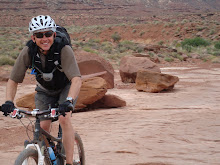Surprise! It is the weekend, and it is snowing! This weather pattern has becoming annoyingly familiar over the last 2 months. We may get up to a foot of heavy, wet spring snow. The moisture is needed – I know that and am trying not to be completely unreasonable. But is it too much to ask for a dry and sunny Saturday? Or Sunday? Or even 3 hours on one day or the other . . . sigh.
As both of my regular readers know (you know who you are and I appreciate you!!), I usually save up my movie reviews and give you a whole month at a time. Today we watched a movie while working out that I believe deserves its own blog entry.
We had a 90 minute light endurance ride on the schedule, so I picked up the movie “King Corn,” which had a perfect 90 minute run-time. Our neighbor had mentioned it a few weeks ago, and I thought it sounded at least sort of interesting. In reality, I found it incredibly thought provoking.
King Corn (2007) - the movie's premise is “For the first time in American history, our generation was at risk of having a shorter lifespan than our parents. And it was because of what we ate.” —Curt Ellis, KING CORN filmmaker
Behind America’s dollar hamburgers and 72-ounce sodas is a key ingredient that quietly fuels our fast-food nation: corn. In KING CORN, recent college graduates Ian Cheney and Curt Ellis leave the east coast for rural Iowa, where they decide to grow an acre of the nation’s most powerful crop.
The filmmakers arrive in the Midwest enthusiastic about their new endeavor. For their farm-to-be, they choose a tiny town in Floyd County, Iowa—a place that, coincidentally, both Ian and Curt’s great-grandfathers called home three generations ago.
They lease an acre of land from a skeptical landlord, fill out a pile of paperwork to sign up for subsidies and discover the U.S. government will pay them 28 dollars for their acre.
Ian and Curt start the spring by injecting ammonia fertilizer, which promises to increase crop production four-fold.
Then it’s planting time. With a rented high-tech tractor, they set 31,000 seeds in the ground in just 18 minutes.
Their corn has also been genetically modified for another yield-increasing characteristic: herbicide resistance. When the seedlings sprout from Iowa’s black dirt, Ian and Curt apply a powerful herbicide to ensure that only their corn will thrive on their acre.
By summer, their modern farm is thriving, and the Corn Belt is moving toward a record harvest of 11 billion bushels of corn.
But where will all that corn go? With their crop growing head-high, Ian and Curt leave the farm to see where America’s abundance of corn ends up. As they enter America’s industrial kitchen, they are forced to confront the realities of their crop’s future.
In Brooklyn, it sweetens the sodas of a diabetes-plagued neighborhood. In Colorado, it fattens the feed trough of a 100,000-head cattle feedlot.
Ian and Curt are increasingly troubled by how the abundance of corn is helping to make fast food cheap and consumers sick, driving animals into confinement and farmers off the land.
Animal nutritionists confirm that corn feeding can make cows sick and beef fatty, but it also lets consumers have fast food at low prices. As feedlot operator Bob Bledsoe says in KING CORN, “America wants and demands cheap food.”
As Ian and Curt discover, almost everything Americans eat contains corn. High-fructose corn syrup, corn-fed meat, and corn-based processed foods are the staples of the modern diet.
America’s record harvests of corn are supported by a government subsidy system that promotes corn production beyond all market demand. As Ian and Curt return to Iowa to watch their 180 bushel harvest fill the combine’s hopper and make its way into America’s food, they realize their acre of land shouldn’t be planted in corn again—if they can help it.
I should also confess that I just finished reading Michael Pollan’s The Botany of Desire earlier this week, so perhaps I was already a bit sensitive to food production issues. I found that book to be interesting, but I have to agree with this review – Mr Pollan tends to ramble.
The chapters on growing apples and potatoes, and how the current lack of biodiversity creates a host of unintended and possibly dangerous consequences, were fascinating. The chapters on tulips and marijuana were, for me, just boring filler.
Making better choices about the food I eat has been one of my goals this year. I believe I’ve made progress in breaking some bad habits, or at least being conscious of those habits, and taking responsibility for my choices.
The information in The Botany of Desire, King Corn, and this piece by Mr Pollan in the New York Times (“Unhappy Meals”), as well as the plethora of other information I soak up from my subscriptions to Eating Well and Cooking Light, help me stay on track and remain mindful.
The choices we make each time we go to the supermarket, to a restaurant, or to the vending machine have far-reaching economic, social and environmental consequences.
Subscribe to:
Post Comments (Atom)


Sounds very thought provoking. I truely want to make smarter food choices for our family and go in spurts of doing really well until the bank account starts to take the sharp nose-dive that comes along with buying organic. I always look forward to summer when at least the organic produce choices are more competitive but it is those meat and dairy prices that make it tough!!! At least we have eliminated all of the fast-food burger joints from our lives. I hope that will instill some good habits for the girls to build on.
ReplyDelete